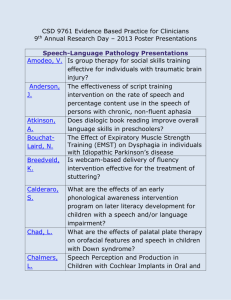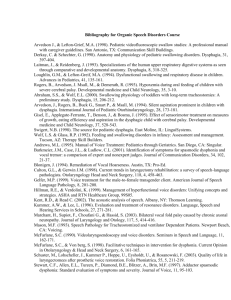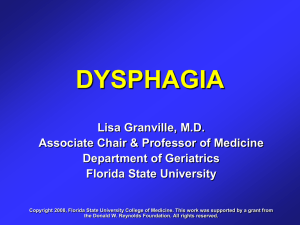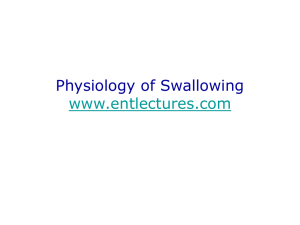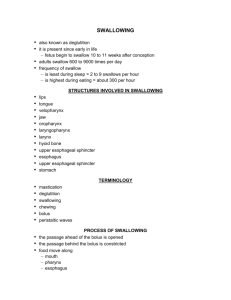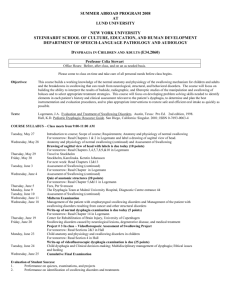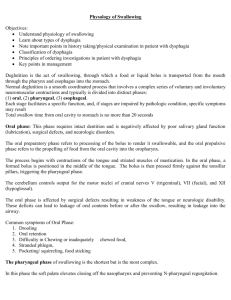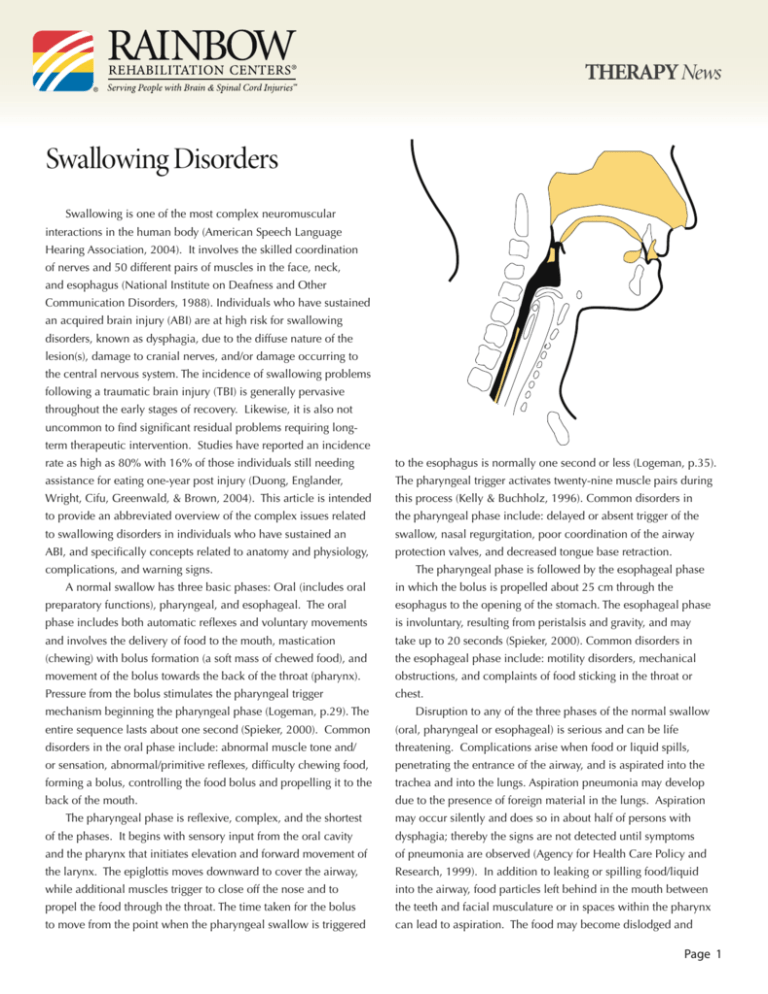
Therapy News
Swallowing Disorders
Swallowing is one of the most complex neuromuscular
interactions in the human body (American Speech Language
Hearing Association, 2004). It involves the skilled coordination
of nerves and 50 different pairs of muscles in the face, neck,
and esophagus (National Institute on Deafness and Other
Communication Disorders, 1988). Individuals who have sustained
an acquired brain injury (ABI) are at high risk for swallowing
disorders, known as dysphagia, due to the diffuse nature of the
lesion(s), damage to cranial nerves, and/or damage occurring to
the central nervous system. The incidence of swallowing problems
following a traumatic brain injury (TBI) is generally pervasive
throughout the early stages of recovery. Likewise, it is also not
uncommon to find significant residual problems requiring longterm therapeutic intervention. Studies have reported an incidence
rate as high as 80% with 16% of those individuals still needing
to the esophagus is normally one second or less (Logeman, p.35).
assistance for eating one-year post injury (Duong, Englander,
The pharyngeal trigger activates twenty-nine muscle pairs during
Wright, Cifu, Greenwald, & Brown, 2004). This article is intended
this process (Kelly & Buchholz, 1996). Common disorders in
to provide an abbreviated overview of the complex issues related
the pharyngeal phase include: delayed or absent trigger of the
to swallowing disorders in individuals who have sustained an
swallow, nasal regurgitation, poor coordination of the airway
ABI, and specifically concepts related to anatomy and physiology,
protection valves, and decreased tongue base retraction.
complications, and warning signs.
in which the bolus is propelled about 25 cm through the
A normal swallow has three basic phases: Oral (includes oral
The pharyngeal phase is followed by the esophageal phase
preparatory functions), pharyngeal, and esophageal. The oral
esophagus to the opening of the stomach. The esophageal phase
phase includes both automatic reflexes and voluntary movements
is involuntary, resulting from peristalsis and gravity, and may
and involves the delivery of food to the mouth, mastication
take up to 20 seconds (Spieker, 2000). Common disorders in
(chewing) with bolus formation (a soft mass of chewed food), and
the esophageal phase include: motility disorders, mechanical
movement of the bolus towards the back of the throat (pharynx).
obstructions, and complaints of food sticking in the throat or
Pressure from the bolus stimulates the pharyngeal trigger
chest.
mechanism beginning the pharyngeal phase (Logeman, p.29). The
entire sequence lasts about one second (Spieker, 2000). Common
(oral, pharyngeal or esophageal) is serious and can be life
disorders in the oral phase include: abnormal muscle tone and/
threatening. Complications arise when food or liquid spills,
or sensation, abnormal/primitive reflexes, difficulty chewing food,
penetrating the entrance of the airway, and is aspirated into the
forming a bolus, controlling the food bolus and propelling it to the
trachea and into the lungs. Aspiration pneumonia may develop
back of the mouth.
due to the presence of foreign material in the lungs. Aspiration
may occur silently and does so in about half of persons with
The pharyngeal phase is reflexive, complex, and the shortest
Disruption to any of the three phases of the normal swallow
of the phases. It begins with sensory input from the oral cavity
dysphagia; thereby the signs are not detected until symptoms
and the pharynx that initiates elevation and forward movement of
of pneumonia are observed (Agency for Health Care Policy and
the larynx. The epiglottis moves downward to cover the airway,
Research, 1999). In addition to leaking or spilling food/liquid
while additional muscles trigger to close off the nose and to
into the airway, food particles left behind in the mouth between
propel the food through the throat. The time taken for the bolus
the teeth and facial musculature or in spaces within the pharynx
to move from the point when the pharyngeal swallow is triggered
can lead to aspiration. The food may become dislodged and
Page 1
Therapy News
Swallowing Disorders continued
penetrate the airway and be aspirated. Esophageal complications
References:
may include the development of a pocket outside the esophagus
Agency for Health Care Policy and Research (1999 March),
caused by weakness in the esophageal wall. The abnormal
United States Department of Health and Human Services.
pocket traps food being swallowed. While lying down or
Diagnosis and treatment of swallowing disorders in acute-
sleeping, the undigested food may be drawn back up into the
care stroke patients. [AHCPR Pub. No. 99-E023]. Washington,
pharynx. The esophagus may also be too narrow, causing food
DC. Retrieved from Medscape online database: http://www.
to stick and preventing other foods or liquid from entering the
medscape.com
stomach.
American Speech Language Hearing Association (2004).
Persons can have one or more type of dysphagia at the same
time. Warning signs of dysphagia include:
Special Populations: Dysphagia – 2004 edition [7 paragraphs].
• Coughing while eating or drinking
Communication Facts. Available: http://www.asha.org/members/
• Coughing after the swallow
research/reports/dysphagia.htm
• Choking, coughing up food particles
• Uncoordinated chewing or swallowing
Duong, T.T., Englander, J., W right, J., Cifu, D.X., Greenwald, B. D.,
• Food pocketed between the cheek or gum
& Brown, A.W. (2004). Relationship between strength, balance,
• Leakage of food/liquid through the nose
and swallowing deficits and outcome after traumatic brain injury:
• Drooling/leakage of liquid or food from the mouth
A multicenter analysis. [On-line]. Archives of Physical Medicine
• Slow eating
and Rehabilitation, 85, 1291-1297. Abstract from: Brain Injury
• Labored or effortful swallowing
Association of America. Available: http://www.biausa.org/Pages/
• Complaints of pain after or during eating
modelsystems/tbi_ms_76.html
• Wet cough
• Gurgling voice
Kelly, J. H.& Bucholz, D.W. (1996, May). Nutritional management
• Facial grimacing/reddening of the face
of the patient with a neurologic disorder. Ear, Nose & Throat
• Eye watering
Journal, 75(5), pp. 293-299.
When one or a combination of warning signs are noted, a
consultation for a possible swallowing disorder is immediately
Logeman, Jerri A., (1998). Evaluation and Treatment of Swallowing
warranted. The consultation from a physician or speech-language
Disorders, 2nd edition. TX: pro.ed
pathologist will include testing to look at the integrity of the
swallowing mechanism. Following testing, recommendations
National Institute on Deafness and Other Communication
and individualized treatment plans are created to address the
Disorders (1998 October), National Institutes of Health.
specific impairments and to develop efficient and effective
Dysphagia. [NIH Pub. No. 99-4307]. Washington, DC. Available:
treatment. Research has indicated swallowing rehabilitation can
http://www.nidcd.nih.gov/health/voice/dysph.asp
be successful in reducing the risk of pneumonia and improving
nutritional intake/status (Logeman, p.246).
Spiekler, Michael. (2000, June). Evaluating Dysphagia [34
paragraphs]. American Family Physician, 61. Available: http://
Written by Angie McCalla, MS, CCC-SLP, CBIS. Copyright
January 2005 – Rainbow Rehabilitation Centers, Inc. All rights
reserved. Printed in the United States of America. No part of
this publication may be reproduced in any manner whatsoever
without written permission from Rainbow Rehabilitation Centers,
Inc. For information, contact the editor at:
www.aafp.org/afp/20000615/3639.html
RainbowVisions Magazine
Rainbow Rehabilitation Centers, Inc.
5570 Whittaker Road, Ypsilanti, MI 48197, USA
E-mail: rainbowvisions@rainbowrehab.com
Page 2

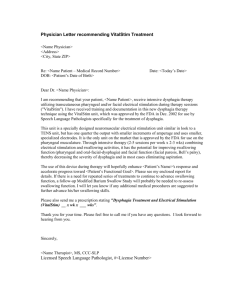
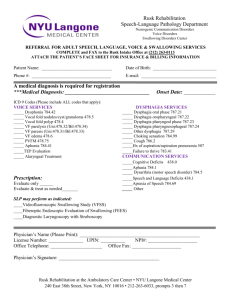
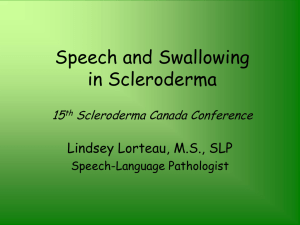
![Dysphagia Webinar, May, 2013[2]](http://s2.studylib.net/store/data/005382560_1-ff5244e89815170fde8b3f907df8b381-300x300.png)
